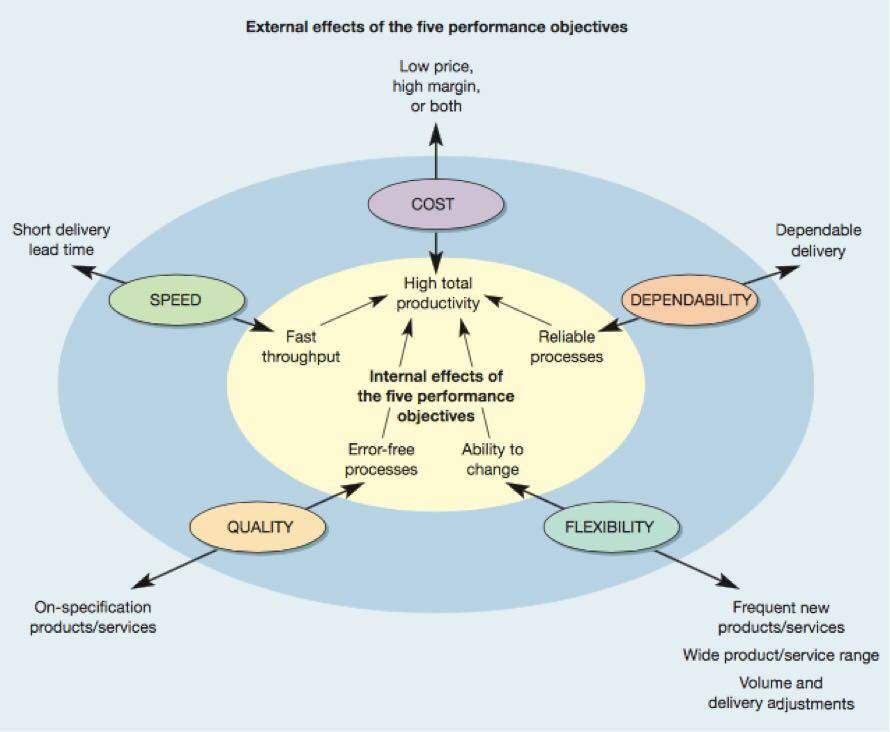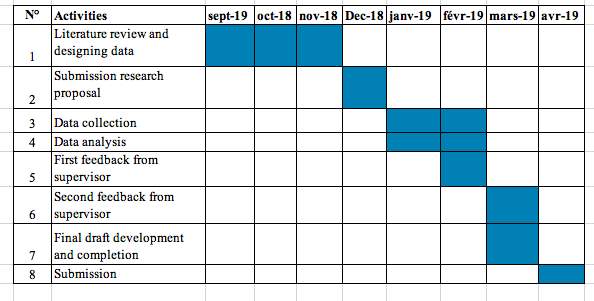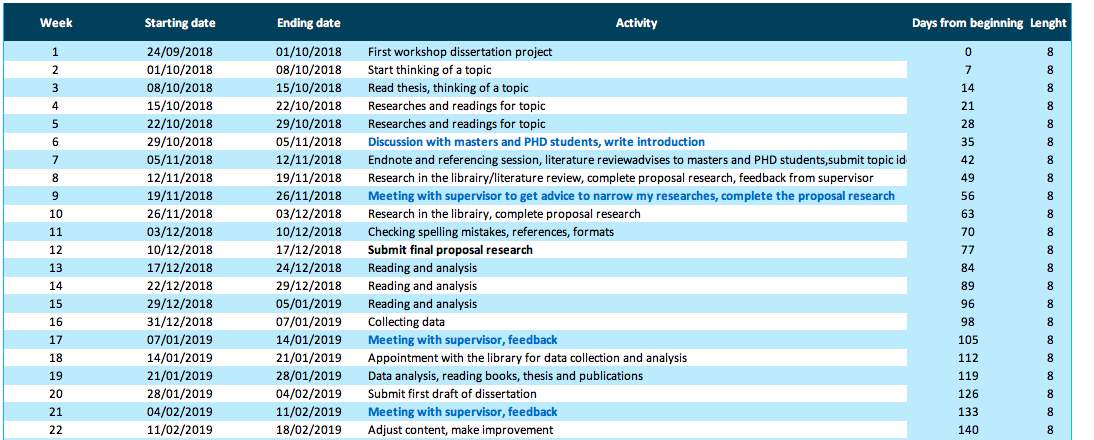Comparison between Vietnam and Singapore MNE Performance Objectives
Info: 3208 words (13 pages) Dissertation
Published: 9th Dec 2019
Tagged: International Business
Five operations performance objectives
Case study: Comparison between Vietnam and Singapore MNEs
Table of content
Introduction ……………………………………………………………………………………………………………… 3
Literature Review ……………………………………………………………………………………………………… 4
The five Operation Performances objectives and their performance measurement………….. 4
Framework: The Five Operations Performance objectives……………………………………………….. 4
Research Methodologies ……………………………………………………………………………………………. 7
Gantt Project: Timeline over the year………………………………………………………………………… 8
References ………………………………………………………………………………………………………………… 9
Lists of Figure
Figure 1: Framework of the five Operations performance of the internal and external effect of the performance’s objectives……………………………………………………………………………………….. 5
Introduction: (350 words)
This research is aiming to compare two countries of South East Asia (ASEAN), Vietnam as an emerging economy, Singapore as a Newly Industrialized Countries (NIC). This case study will examine the economic background to compare the Five Operations Performance (FOP): cost, speed, flexibility, dependability and quality, highlighting the Multinational Enterprise (MNEs) (Tong et al. 2018) business’ evolution. This selection is due to their economic gap between them more relevant to emphasis their differences in terms of objectives performance (Slack et al. 2016). As a growing country Vietnam has faced several threats such as: political’s instability and corruption dealing with a strong emerging economy (Ogendo 2017). Indeed, Vietnam and Singapore have reached different level of operation management. Vietnam is still in his early development’s stage attempting mainly to lower its production’s cost instead of quality and diversity (Nguyen et al. 2011).
This research will provide for readers as managers, directors, investors an analysis of the FOP objectives differences and their performance measurement providing suggestions fostering the performance’s improvement. Meanwhile, most managers will have a clear explanation to fully understand and manage their company based in Vietnam. Furthermore, there are no exiting studies on comparative operation performance objectives and its impact on strategy performance combined to a lack of bilateral comparative study of Vietnam and Singapore. This study attempts to make a contribution to reduce this research gap (Elman et al. 2016a).
This part aims to explain which Sustainable Development Goals (SDG) could be implemented regarding the MNEs strategy performances. Concerning the goals 8 “Decent Work and Economic Growth” by 2030 would improve the strategy for trade in emerging country as Vietnam. Allowing the mother company leading toward new implementation systems as driving them toward their ecosystems could foster the implementation of the managerial, operational best practices fostering technology adoption. (Jonathan Woetzel et al., 2018).
The first part of this research will provide introductory background and rationality. The second part will bring information with relevant literature. The third part will assess and analyse the comparative case studies (Gerring 2007) of Vietnam and Singapore. Chapter four will focus and debate on the data analysis and synthesis with the findings. The final part will ensure conclusion and implications.
Literature Review
The five operations performance objectives and their performance measurement (430 words)
This research attempts to compare the FOP objectives of two countries. First, we highlight the relevance of the FOP among the organisation. Indeed, these operations determine “where” the issues are located and their consequences. Its implication to an organisation’s global success can be higher than expected. They are likely to represent the chore of improvement for the entire firm’s system (Pagell and Krause, 2004). The five operation are involved toward “process” equivalent to “how” tasks are proceeded (Yu et al. 2015). An effective operation management is the most efficient solution to deliver products and services to create a sustainable success in each company (Slack et al. 2016).
In the regards of business improvement approaches and techniques in terms of performance measurement, advise that firms perform better whether they use formalised, balanced and integrated performance measures in their management system (Hoque and James, 2000; Davis and Albright, 2004). Besides, the use of performance measurement systems, such as the balanced scorecard, does not make any difference within the company’s performance (Neely et al.,2004; Ittner et al., 2003). Regarding the balanced scorecard (Kaplan and Norton, 1992, 1996, 2001), in small period operations are not able to succeed outstanding performance through their operations objectives. Besides, the key performance measured and used as indicators are named KPI (Key Performance Indicator) highlights strategic objectives. As a result, it may be challenging to “target” the selected quantity assessed used to emphasize the KPI. (Slack et al. 2016).
Trade-offs as decision-making leading to improvements only whether one performance objectives can be succeeded while sacrificing another performance. The operation strategy improvement pattern can change its position and/or overcome its performance trade-offs (Upadhaya et al. 2014). Henceforth, the making-decision that are undertaken within each operation and the path it sets forth about its day-to-day activities will affect the entire operation’s group (Koufteros et al. 2014).
In this research the speed’s unit can observe the time as a duration: hours or days (Hill, 1989). The cost can be measured in quantity depending on the national currency (Cua et al,. 2006). As an assessment, the quality is related to the satisfaction and dissatisfaction of services or products from customers (McKone-Sweet et al,. 2006). The flexibility is gauged in quantity such as: volume in term of quantity delivered yearly (Hallgren and Olhager, 2009). The dependability is assessed in term of accuracy achieving the delivery on time (Slack et al,. 2013). Whether a company focus on its “cost” performance as insufficient they divided it into efficiency in terms of “operation”, “staff productivity”, highlighting the origin of the low performance (González-Benito 2010).
Framework: The Five Operations Performance objectives (FOP) (520 words)
According to Krause et al. (2001) illustrates that a purchasing role’s strategy also could be impacted linked (Hayes and Wheelwright’s,1984) challenging aims such as: speed, quality, cost, dependability, and flexibility.
Flexibility represents the capability “what”, “how” or “when” it is doing, the ability of a system to cope with changes (Gupta and Buzacott, 1989). As a key solution, it increases the variety of volumes and delivery dates of services/products reducing costs thanks to quick decision-making and adaptability. It fosters adaptation as speedy service depends on the operation’s flexibility while diminishing the waste of time in “changing over” from each task. Thus, maintaining the operation on time will forestall from unexpected events (Yu et al. 2015).
Dependability has the aim of doing thing in time to provide products or services exactly when needed or are expected by the customer. The importance is attributed to the speedy and reliability fulfilling suppliers’ purchasing orders. (González-Benito 2010).It sets forth a better way for sustainable delivery of services and products. Saving time from any unexpected event, from inefficient time-management providing stability from its consequence regarding the quality in operation’s time by maintaining it (Zhang et al.,2002).
Speed includes the elapsed time between customer requesting products and services when they receive it. The faster the more likely the customer will buy it (Slack et al. 2016). It brings the solution to reduce the delivery services’ time and affect costs as a fast delivery would increase them. Fast response to customers is greatly helped by saving time from decision making as well as movement of items and data within the operation. (Pagell and Krause, 2004).
Figure 1: Framework of the five Operations performance of the internal and external effect of the performance’s objectives.

Source: Slack, Nigel, Brandon-Jones, Alistair Johnston, Robert (2016)
Quality as in term of strategy in the purchase sector means the firm’s aim is to achieve and set forth high levels of functionality, trust and duration in the products sold, as well as the ability of the suppliers is to respond to any issues.(González-Benito 2010). Each operation is related toquality as an efficient objective owning a major impact on customer fulfilment or discontent. Henceforth, it reduces the mistakes made in every process in the operation. Enhancing the dependability, by delivering higher services and products in terms of quality increasing the costs is not the only impact from a lack of quality (Suarez et al., 1992).
Cost strongly linked to the price as main operation objective, as a result, every company will strive to maintain the cost-reduction (Slack et al. 2016).It is often a major objective within operation management. Thus, every organisation tend to mitigate the cost of production allowing them to set a lower price to their customers (Slack et al. 2016).
Through a range of literature, a performance strategy model has been selected (figure 1) and used to highlight the relationship among the FOP (Slack et al. 2016).This model provides analysis through the FOP established in the MNEs in this comparative case study. Indeed, it remains a relationship between each performance objectives while influencing the cost performance such as its reduction. Therefore, to improve the cost objectives, the other objectives performances have to be enhanced.
Research methodology (415 words)
Throughout the related literatures the five operations performance objectives and performance measurement are examined. As a result, a framework of the FOP objectives is applied within two MNEs. This research is focusing on one specific case study as comparison using the FOP’s framework. In this procedure, we assess the FOP objectives in each country using deduction method. Opposite to a holistic approach, this research is considered as an embedded case study as a mean of including more than one unit aimed to be analysed and usually using both qualitative and quantitative analysis. (Elman et al. 2016b). In order to quantify them, a unit of measurement is needed to fulfill our study. (Elman et al. 2016a).
Furthermore, this case study examines in detail of two cases. Usually, the selected cases are considered as emblematic of a wider population of cases, each case evaluating a specific aspect (Gerring 2007). Owning benefits such as developing ideas toward extensive researches in the future while capturing the ‘lived reality’ (Hodkinson and Hodkinson, 2001). Combine with the triangulation as an understanding of validation (Campbell & Fiske, 1959), as a permanent comparative method including data’s comparison from various sources (Fielding 2012).
In the next step, we compare the data collected by highlighting the similarities or differences for each operation of a MNE based in both countries providing the same service. These relationships will be then mapped using the framework built. Patterns will be examined leading to new insights and deductions. Henceforth, based on the study’s results some suggestions will be established allowing managers and directors to make improvement within their systems. This research analyses Singapore airlines and Vietnam airlines as MNEs focusing on the transportation service to make the comparison more relevant. Giving a mere access to their data and disclosing their financial and managerial operation applicable to the FOP will provide a broaden analysis of the company’s performance.
This study may encounter some limitations as the few numbers of selected cases study as the research will depend much on secondary data challenged by the quality and the lack of data, which require further research and an accurate analysis. In this research the source of my data embraces theoretical literature, annual report 2017/2018, official records, books, publication with four stars journals and various websites sources such as IBIS, Passport, GCR, which we believe will be an efficient support to enrich and analyse this case study. Further research should explain the implementation of the five operations performance within organisation highlighting the understanding of their objectives.
Gantt Project: Timeline over the year 2018-2019

Gantt Project detailed: Timeline over the year 2018-2019


References
(de Leeuw and van den Berg 2011; He et al. 2017)
Bititci, U. S., Mendibil, K., Nudurupati, S., Garengo, P. and Turner, T. (2006) Dynamics of performance measurement and organisational culture. International Journal of Operations & Production Management 26 (12), 1325-1350.
De Leeuw, S. and van den Berg, J. P. (2011) Improving operational performance by influencing shopfloor behavior via performance management practices. Journal of Operations Management 29 (3), 224-235.
Elman, C., Gerring, J. and Mahoney, J. (2016a) Case Study Research. Sociological Methods and Research 45 (3), 375.
Elman, C., Gerring, J. and Mahoney, J. (2016b) Case Study Research: Putting the Quant Into the Qual. Sociological Methods & Research 45 (3), 375-391.
Fielding, N. G. (2012) Triangulation and Mixed Methods Designs: Data Integration With New Research Technologies. Journal of Mixed Methods Research 6 (2), 124-136.
Gerring, J. (2007) Case study research: principles and practices. Cambridge, Cambridge University Press.
González-Benito, J. (2010) Supply strategy and business performance: An analysis based on the relative importance assigned to generic competitive objectives. International Journal of Operations and Production Management 30 (8), 774-797.
He, Y., Sun, H., Ni, W. and Ng, S. C. H. (2017) Re-examining the effects of supplier integration on operations performance: a relational view. International Journal of Operations and Production Management 37 (12), 1702-1721.
Koufteros, X., Verghese, A. and Lucianetti, L. (2014) The effect of performance measurement systems on firm performance: A cross-sectional and a longitudinal study. Journal of Operations Management 32 (6), 313-336.
Nguyen, T. N., Truong, Q. and Buyens, D. (2011) Training and firm performance in economies in transition: a comparison between Vietnam and China. Asia Pacific Business Review 17 (1), 103-119.
Ogendo, J. L. (2017) Emerging economy MNEs: exploring the integration of knowledge transfer and strategy for sustainable performance. Basingstoke, Palgrave Macmillan.
Slack, N., Brandon-Jones, A. and Johnston, R. (2016) Operations management. Eighth edition. Upper Saddle River: Pearson.
Tong, X., Lai, K.-h., Zhu, Q., Zhao, S., Chen, J. and Cheng, T. C. E. (2018) Multinational enterprise buyers’ choices for extending corporate social responsibility practices to suppliers in emerging countries: A multi-method study. Journal of Operations Management.
Upadhaya, B., Munir, R. and Blount, Y. (2014) Association between performance measurement systems and organisational effectiveness. International Journal of Operations & Production Management 34 (7), 853-875.
Yu, K., Cadeaux, J. and Luo, B. N. (2015) Operational flexibility: Review and meta-analysis. International Journal of Production Economics 169, 190-202.
Cite This Work
To export a reference to this article please select a referencing stye below:
Related Services
View allRelated Content
All TagsContent relating to: "International Business"
International Business relates to business operations and trading that happen between two or more countries, across national borders. International Business transactions can consist of goods, services, money, and more.
Related Articles
DMCA / Removal Request
If you are the original writer of this dissertation and no longer wish to have your work published on the UKDiss.com website then please:




